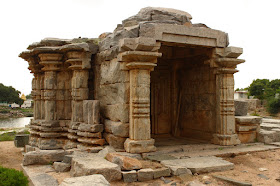..continued from Itagi Mahadeva Devasthana - part 1
August 15, 2017
Itagi temple complex consists of about 15 temples and a well. The first part of this article is only about the main temple i.e. Mahadeva Devasthana. This part will cover the remaining temples and well. This west facing temple is diagonally opposite to main temple. As you see, this is an incomplete structure. On seeing such structure, partly skinned mango comes to my mind. One can get an insight into building techniques of those times. Given the space constraints here, looks like this is more or less the size (length and breadth) when finished.
This structure is close to the south-east corner of the complex, it has twenty sides and two doors on north and south faces. The front portico has sloping roof, this design is mostly seen in Kadamba temples. Next to this is another larger structure, double in size, square in plan.
Neat job by stone dressers and builders. I've seen these types of wells in ancient temples all over Karnataka and parts of Andhra Pradesh. People back then had dedicated so much of their time and energy into spiritual development. Such activities also provided employment which in turn curbed poverty and crime. Leaders were committed to maintaining peace in the society.
In the space between the chatra, well and main temple is this idol of Lord Brahma, the creator of this universe.
As seen from the southern side of the well. The well is designed to accommodate good number of people at the same time. On the sides are platform to keep personal items.. clothes, pooja material, etc. There are four east facing temples on the left hand side and straight ahead are south facing.
Lets take a closer look at the smaller temples. This complex has seven temples of this size, all in this stage of construction. Chalukyans had this practice of building smaller temples around the main temple.. can be seen at Aihole and at Papnashi groups of temples near Alampur in Andhra Pradesh.
Lets take a closer look at the smaller temples. This complex has seven temples of this size, all in this stage of construction. Chalukyans had this practice of building smaller temples around the main temple.. can be seen at Aihole and at Papnashi groups of temples near Alampur in Andhra Pradesh.
This temple is almost same as the previous one. As Sadhguru states, every temple would have had a purpose, they were (are) energy centers, where people came to gain cosmic energy, charge their souls.
Another east-facing temple, almost finished. I think this was restored recently. Overall structure is similar to the previous temple, small Garbhagudi with a wide Sabhamantapa with Sukhanasi around it. People could either sit on the floor or the seating platform. Lets take a look at the interior..
Though the temple looks small from outside, the inside is quite spacious. A vestibule connects the Garbhagudi to Sabhamantapa. The vestibule has a beautiful mesh screen. Two niches flank the vestibule entrance, place where idols of Ganesha or Parvati or Shanmugha are kept. Here we can see 4 or 5 types of pillar designs.
The Garbhagudi door-frame. This is a standard design in Chalukyan temples.. marvelous creations. You can sit and stare at this artwork for hours and still remain amazed. The shapes, dimensions and proportions.. how did the designer ever imagine it and how the sculptor produced it. Feel so helpless that I cannot go back in time when these temples were being made.. or could there be a way.. mind-power can make anything possible.
A closer look at the bottom portion of the door frame. Wondering what the ribbed thing with three circular hole is. The human characters, the miniature pillar, they look so realistic. Simply amazing!
This is a view from one of the smaller incomplete temples. I'm standing on its dance stage. Surely the stage dimensions and form has a connection with the type of dance performed on it. A dancer wouldn't have to look at the floor to know his/her position.. they could feel it through their feet, I think.
This is that temple with the best dance stage in this complex. In this complex are four south-facing temples, including this one. By the way, there's one temple facing every cardinal direction here. Behind this incomplete structure is another smaller one with a small Shikhara.
A lotus on a pedestal. Seen here is the rear side of the temple described previously. The exterior has decorative pillars and niches around it.
Coming to the last temple which is actually the first item as we enter this complex. As you see this too is incomplete.. Shikhara and Sabhamantapa roof are the pending works.
This is a restored temple, the pillars of the Sabhmantapa are made by present day sculptors. I remember seeing them at work during my first visit in October 2009. Work well done!
..shall continue in Itagi Mahadeva Devasthana - part 3.



















No comments:
Post a Comment